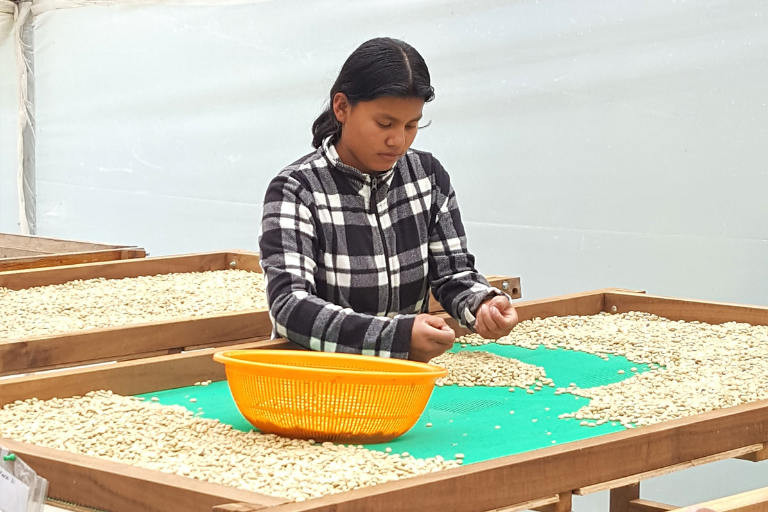The Epic Journey Coffee Takes to Arrive to Our Cups
By Tyler Workman

If you had to take a guess, how far would you say the coffee you are drinking today has traveled to get to you from its origin? It’s not something that we think about too often—but we should! It may have traveled a few thousand miles if it’s from somewhere in Central America. Perhaps it traveled over ten thousand miles if it’s coming from the other side of the world, like Africa or Asia. Knowing that our coffee travels thousands of miles before arriving in our cup is pretty awesome, but there is so much more to it than just the number of miles the coffee has come. There is a lot that happens to these complex little beans before they end up in our morning brew. In this month’s blog, I’d like to discuss the many unique stops the coffee makes before we pour it into our cups every day.
Harvesting and Processing at Origin
The journey begins at origin. From the misty Andes of South America, to the lush rainforests of Asia, to the beautiful hills and plains of Africa, and all types of landscape and climate in between, coffee origins are always fascinating and always diverse. Whether the coffee comes from a single farm or from a co-op or association, it is grown and harvested at origin, and the characteristics of each of these regions typically determine the way the coffee will be harvested. In countries like Brazil, where coffee farms are large and flat, machinery can often be used to harvest. In countries like Ecuador, however, coffee may be grown on small mountainside farms where the coffee plants are more difficult to access and where the coffee must be harvested by hand.

After harvest, coffee can go through different processes such as fermentation, washing, and drying, depending on the approach used by the producer. These are the processes that give us a variety of coffees to choose from—washed, natural, honey, etc.—and that help to infuse our coffees with their individual tasting notes and aromas.
Sometimes, coffee farmers don’t have the resources and infrastructure needed to process their coffee. While some producers have access to greenhouses, drying beds, depulpers, water, etc., to process their coffee at their own farms, other producers have none of this. Yes, you read that right: some coffee farmers do not even have water readily available at their farms. In the most challenging of circumstances, some producers may very well have to take their coffee completely unprocessed (besides having been picked) to another location for processing. This is just another of many stops in the coffee journey.
Getting the Coffee Ready for Export
Getting the coffee ready for export is a multi-step process that requires very specific and pricy equipment, and in many cases, producers do not have the necessary machines to complete this process. This is very similar to the situation that is often encountered in the previous step. Without these expensive machines, the coffee has to be transported from the farm to a hulling facility for processing. Depending on the size of the country and the availability of these facilities, the coffee may very well have to travel several hours to the designated in-country warehouse.
These warehouses are often owned by the exporters themselves, and as a result, this may be the last time many producers see their coffee. Because of the way the supply chain is set up, coffee farmers know their exporters, but after the coffee is exported, their connection to their own product is broken. What happens to the coffee they worked so hard to grow may just end up as a question mark at this point. This is a large part of the reason why transparency in the coffee industry is so vital, and why the specialty coffee movement has made great strides to bridge the gap between producers and buyers, creating opportunities to build relationships and to validate farmers for their efforts. Much more can be said about this topic—but I will save that for another blog!

Transporting Coffee to Destination
At the exporting facility, the coffee is now bagged and ready to be transported to its final destination. Although there are two modes of transportation by which the coffee may be brought from origin to destination (sea freight or air freight), transporting coffee by sea has been and continues to be the most common method used in the industry. Sea freight is much cheaper and more accessible, and it allows for larger quantities of coffee to be transported at the same time. So not only has your coffee come from an entirely different country and continent, but it has likely also sailed across the sea to get to you!
Depending on the country of origin, the bagged coffee may have to travel several hours or days before it reaches the nearest port. Think of countries like Bolivia, Nepal, or Uganda, which are all landlocked coffee-producing countries. Their coffees will have to clear customs twice: once as the coffee crosses the border into the country with sea access, and again at the port of exit.
Up to this point, the coffee has traveled from the farm all the way to a container in a ship that will likely take weeks before it arrives to its final destination. In an ideal world, it should be smooth sailing from here, but we have to remember that often, coffee can be stranded on the ship or sitting at a port for a long time due to weather conditions, political issues, challenges clearing customs, or even pandemics that disrupt the supply chain.

Roasters Receiving and Distributing Coffee
After the coffee has finally arrived at the port of entry and cleared customs, it is typically transferred to a holding warehouse. In the United States, there are several major ports—including Houston, Seattle, and New Jersey—where major coffee warehouses are located, and where coffee is stored until it is ready to be shipped out to the roaster. Because many of these warehouses are holding facilities for several coffee importers, the amount of coffee inside is almost beyond imagination—countless aisles of nothing but stacks upon stacks of burlap coffee bags as far as the eye can see!

In the meantime, roasters work directly with the importers and arrange delivery of the coffee from the warehouse to the roastery. Depending on the location of the roastery and the holding warehouse, the coffee may need to travel across several states before the roaster can transform the beans into the roasted delight that we all enjoy so much!
You might think that the coffee’s journey ends with the roaster. But don’t forget that the very last stop in the journey is actually you, the drinker. Like most coffee things I cover in the blogs, this, too, is a complex and multi-layered topic. There are many moving parts in the process—and many stops along the way—that make it possible for coffee to embark on this epic journey and reach its most important destination: your cup.


0 comments